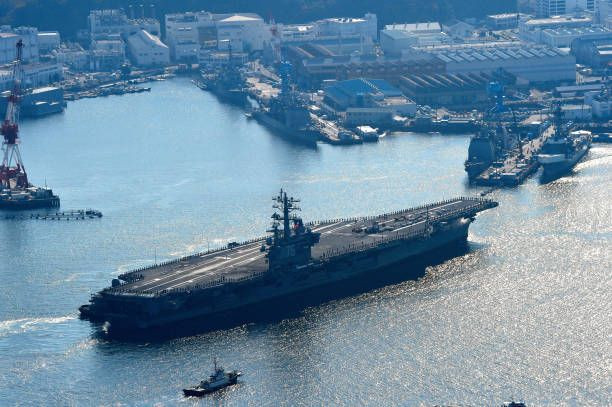USS Ronald Reagan Strike Group Back In South China Sea Amid Chinese Provocations Against Taiwan
KEY POINTS
- This is the second deployment of the strike group this year in the South China Sea
- This comes after China sent warplanes to Taiwan's Air Defense Identification Zone
- The UN Chief had recently warned of a cold war between the two nations
After a side-trip to the U.S. 5th Fleet to assist with Afghanistan withdrawal, aircraft carrier Ronald Reagan and its strike group returned to the South China Sea on Sept. 24. This comes as China stokes tensions in the region by notifying new maritime law and sending warplanes into the Taiwanese Air Defense Identification Zone.
During its second visit, the carrier strike group is conducting fixed and rotary-wing flight operations, maritime strike exercises, anti-submarine operations, and coordinated tactical training, reported Navy Times.
“We look forward to leveraging our recent out-of-area experience as we return to the South China Sea and our rapidly growing alliances and partnerships dedicated to the Indo-Pacific,” Rear Adm. Will Pennington, commander of Task Force 70 and Carrier Strike Group 5, said in a release.
He added that the deployment of the Ronald Reagan carrier strike group to the Middle East and its rapid seamless return to the Pacific displayed its "flexibility and responsiveness."
We’re back in the South China Sea and ready to continue supporting a free and open Indo-Pacific. #ReaganReady #WeAreReagan
— USS Ronald Reagan (@Gipper_76) September 25, 2021
Read more here: https://t.co/IWsYVrQMkO pic.twitter.com/vU819Lgnk9
The carrier strike group was in the South China Sea till June, after which it was assigned to the U.S. 5th Fleet.
Besides, the Reagan strike group also completed anti-submarine warfighting exercises in July "aimed at bolstering safety and familiarization between surface ships and submarines,” the Navy said. The exercise included hunting simulated enemy submarines and performing long-range maritime strikes.
The carrier group includes USS Ronald Reagan, embarked Carrier Air Wing 5, and embarked staffs of Task Force 70, Destroyer Squadron 15, and Ticonderoga-class guided-missile cruiser USS Shiloh.
The redeployment comes a day after China sent warplanes to Taiwan's Air Defense Identification Zone (ADIZ). Reports said the 24 PLA aircraft, including bombers, fighter jets, anti-submarine planes, and airborne early warning and control planes, entered Taiwan's ADIZ in two groups. While 19 planes came the first day, the second cohort of five jets came later in the day.
Recently, the U.N. Secretary-General Antonio Guterres had warned of a cold war between both nations, while urging both U.S and China to repair their "completely dysfunctional" relationship.
The tensions in the region had flared up after China notified a new maritime law that stipulated that all foreign vessels entering its "territory" report to Beijing. Within a week, the US Navy sent one of its Nimitz-class carriers into the disputed waters, angering China.
Meanwhile, Beijing continued its invasion threat towards Taiwan by terming the situation in Taiwan Strait as "complex and grim."
In a congratulatory letter sent to the newly elected leader of Taiwan's main opposition party Taiwan's Kuomintang (KMT) Eric Chu, Chinese President Xi Jinping said both parties could cooperate on "seeking peace in the Taiwan Strait, seeking national reunification and seeking national revitalisation."
Chu was selected as the leader of KMT in an election overshadowed by increasing pressure from China. KMT has always advocated closer relations with Beijing, thereby agreeing to Beijing's demand that it regards Taiwan as a part of China.
However, the Democratic Progressive Party has refused to acknowledge this. Chu had also lost the 2016 presidential election to current President Tsai Ing-wen.

© Copyright IBTimes 2024. All rights reserved.





















